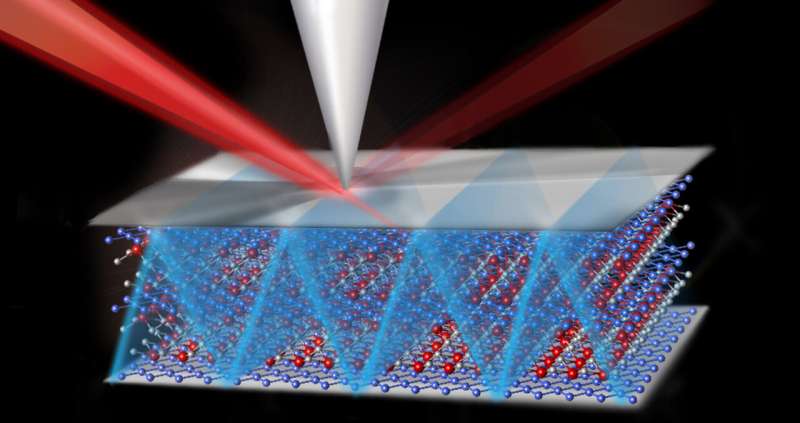OCTOBER 26, 2022 by Ellen Neff, Columbia University Quantum Initiative

When we encounter metals in our day-to-day lives, we perceive them as shiny. That’s because common metallic materials are reflective at visible light wavelengths and will bounce back any light that strikes them. While metals are well suited to conducting electricity and heat, they aren’t typically thought of as a means to conduct light.
But in the burgeoning field of quantum materials, researchers are increasingly finding examples that challenge expectations about how things should behave. In new research published in Science Advances, a team led by Dmitri Basov, Higgins Professor of Physics at Columbia University, describes a metal capable of conducting light. “These results defy our daily experiences and common conceptions,” said Basov.
The work was led by Yinming Shao, now a postdoc at Columbia who transferred as a Ph.D. student when Basov moved his lab from the University of California San Diego to New York in 2016. While working with the Basov group, Shao has been exploring the optical properties of a semimetal material known as ZrSiSe. In 2020 in Nature Physics, Shao and his colleagues showed that ZrSiSe shares electronic similarities with graphene, the first so-called Dirac material discovered in 2004. ZrSiSe, however, has enhanced electronic correlations that are rare for Dirac semimetals.
Whereas graphene is a single, atom-thin layer of carbon, ZrSiSe is a three-dimensional metallic crystal made up of layers that behave differently in the in-plane and out-of-plane directions, a property known as anisotropy. “It’s sort of like a sandwich: One layer acts like a metal while the next layer acts like an insulator,” explained Shao. “When that happens, light starts to interact unusually with the metal at certain frequencies. Instead of just bouncing off, it can travel inside the material in a zigzag pattern, which we call hyperbolic propagation.”
In their current work, Shao and his collaborators at Columbia and The University of California, San Diego observed such zigzag movement of light, so-called hyperbolic waveguide modes, through ZrSiSe samples of varying thicknesses. Such waveguides can guide light through a material and here, result from photons of light mixing with electron oscillations to create hybrid quasiparticles called plasmons.
Although the conditions to generate plasmons that can propagate hyperbolically are met in many layered metals, it is the unique range of electron energy levels, called electronic band structure, of ZrSiSe that allowed the team to observe them in this material. Theoretical support to help explain these experimental results came from Andrey Rikhter in Michael Fogler’s group at UC San Diego, Umberto De Giovannini and Angel Rubio at the Max Planck Institute for the Structure and Dynamics of Matter, and Raquel Queiroz and Andrew Millis at Columbia. (Rubio and Millis are also affiliated with the Simons Foundation’s Flatiron Institute)
Plasmons can “magnify” features in a sample, allowing researchers to see beyond the diffraction limit of optical microscopes, which cannot otherwise resolve details smaller than the wavelength of light they use. “Using hyperbolic plasmons, we could resolve features less than 100 nanometers using infrared light that’s hundreds of times longer,” said Shao.
ZrSiSe can be peeled to different thicknesses, making it an interesting option for nano-optics research that favors ultra-thin materials, said Shao. But, it’s likely not the only material to be valuable—from here, the group wants to explore others that share similarities with ZrSiSe but might have even more favorable waveguiding properties. That could help researchers develop more efficient optical chips, and better nano-optics approaches to explore fundamental questions about quantum materials.
“We want to use optical waveguide modes, like we’ve found in this material and hope to find in others, as reporters of interesting new physics,” said Basov.
More information: Yinming Shao et al. Infrared plasmons propagate through a hyperbolic nodal metal. Science Advances (2022). DOI: 10.1126/sciadv.add6169
Journal information: Nature Physics , Science Advances
Provided by Columbia University Quantum Initiative
Collected at: https://phys.org/news/2022-10-physicists-metal.html?utm_source=nwletter&utm_medium=email&utm_campaign=weekly-nwletter

Leave a Reply